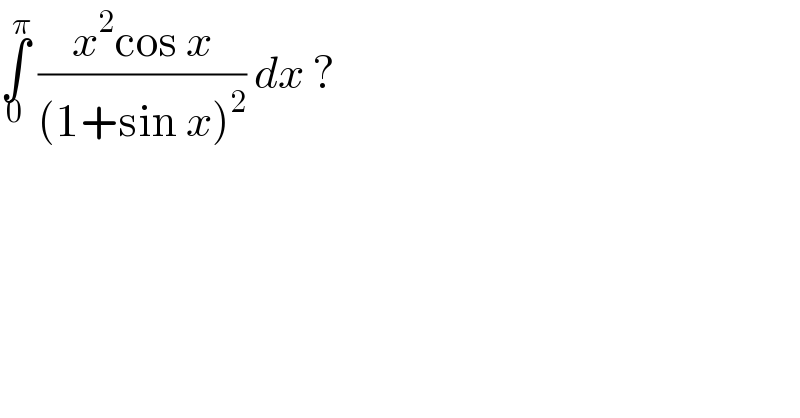Question Number 104220 by bemath last updated on 20/Jul/20

Commented by bemath last updated on 20/Jul/20

Answered by Ar Brandon last updated on 20/Jul/20
![I=∫_0 ^π ((x^2 cosx)/((1+sinx)^2 ))dx , x=π−u I=∫_0 ^π (((π−x)^2 cos(π−x))/((1+sin(π−x))^2 ))dx=−∫(((π−x)^2 cosx)/((1+sinx)^2 ))dx 2I=∫_0 ^π ((x^2 −(π^2 −2πx+x^2 ))/((1+sinx)^2 ))∙cosxdx=∫_0 ^π ((2πx−π^2 )/((1+sinx)^2 ))cosxdx =∫_0 ^π {((2πxcosx)/((1+sinx)^2 ))−((π^2 cosx)/((1+sinx)^2 ))}dx=∫_0 ^π ((2πxcosx)/((1+sinx)^2 ))dx+[(π^2 /(1+sinx))]_0 ^π u(x)=2πx⇒u′(x)=2π , v′(x)=((cosx)/((1+sinx)^2 ))⇒v(x)=((−1)/(1+sinx)) ⇒2I={((−2πx)/(1+sinx))+∫((2πdx)/(1+sinx))}_0 ^π ∫(dx/(1+sinx))=∫((1−sinx)/(cos^2 x))dx=tanx−secx ⇒2I=2π{((−x)/(1+sinx))+tanx−secx}_0 ^π =2π(2−π) ⇒∫_0 ^π ((x^2 cosx)/((1+sinx)^2 ))dx=(2−π)π](https://www.tinkutara.com/question/Q104222.png)
Answered by john santu last updated on 20/Jul/20
![by parts { ((u=x^2 ⇒du=2x dx)),((v=∫ ((d(1+sin x))/((1+sin x)^2 )) =−(1/(1+sin x)) )) :} I= −(x^2 /(1+sin x)) ]_0 ^π +∫_0 ^π ((2x)/(1+sin x)) dx I= −π^2 +∫_0 ^π ((2x)/(1+sin x)) dx set J = ∫_0 ^π ((2x)/(1+sin x)) dx replace x by π−x J = ∫_π ^0 ((2(π−x))/(1+sin (π−x))) (−dx) J=∫_0 ^π ((2π−2x)/(1+sin x)) dx , so we have 2J = ∫_0 ^π ((2π)/(1+sin x)) dx ⇒J = ∫_0 ^π (π/(1+sin x))dx substitute t=x−(π/2) J=∫_0 ^(π/2) π sec^2 ((t/2)) dt = 2π hence we conclude that = −π^2 +2π (JS ⊛)](https://www.tinkutara.com/question/Q104226.png)
Answered by mathmax by abdo last updated on 20/Jul/20
![I =∫_0 ^π ((x^2 cosx)/((1+sinx)^2 ))dx changement x =π−t give I =−∫_0 ^π (((π−t)^2 (cos(π−t)))/((1+sint)^2 ))(−dt) =−∫_0 ^π (((π^2 −2πt +t^2 )cost)/((1+sint)^2 ))dt =−π^2 ∫_0 ^π ((cost)/((1+sint)^2 )) +2π ∫_0 ^π ((tcost)/((1+sint)^2 ))dt −∫_0 ^π ((t^2 cost)/((1+sint)^2 ))dt ⇒ 2I =π^2 [(1/(1+sint))]_0 ^π +2π ∫_0 ^π ((tcost)/((1+sint)^2 ))dt =0 +2π ∫_0 ^(π ) ((tcost)/((1+sint)^2 ))dx by parts u^′ =((cost)/((1+sint)^2 )) and v =t ⇒ ∫_0 ^π ((tcost)/((1+sint)^2 ))dt =[−(t/(1+sint))]_0 ^π −∫_0 ^π −(1/(1+sint))dt =−π +∫_0 ^π (dt/(1+sint)) changement tan((t/2))=u give ∫_0 ^π (dt/(1+sint)) =∫_0 ^∞ ((2du)/((1+u^2 )(1+((2u)/(1+u^2 ))))) =∫_0 ^∞ ((2du)/(1+u^2 +2u)) =∫_0 ^∞ ((2du)/((u+1)^2 )) =[((−2)/(u+1))]_0 ^∞ =2 ⇒2I =2π{−π +2} ⇒I =2π−π^2](https://www.tinkutara.com/question/Q104257.png)
